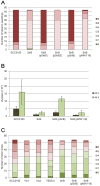Revised phylogeny and novel horizontally acquired virulence determinants of the model soft rot phytopathogen Pectobacterium wasabiae SCC3193
- PMID: 23133391
- PMCID: PMC3486870
- DOI: 10.1371/journal.ppat.1003013
Revised phylogeny and novel horizontally acquired virulence determinants of the model soft rot phytopathogen Pectobacterium wasabiae SCC3193
Abstract
Soft rot disease is economically one of the most devastating bacterial diseases affecting plants worldwide. In this study, we present novel insights into the phylogeny and virulence of the soft rot model Pectobacterium sp. SCC3193, which was isolated from a diseased potato stem in Finland in the early 1980s. Genomic approaches, including proteome and genome comparisons of all sequenced soft rot bacteria, revealed that SCC3193, previously included in the species Pectobacterium carotovorum, can now be more accurately classified as Pectobacterium wasabiae. Together with the recently revised phylogeny of a few P. carotovorum strains and an increasing number of studies on P. wasabiae, our work indicates that P. wasabiae has been unnoticed but present in potato fields worldwide. A combination of genomic approaches and in planta experiments identified features that separate SCC3193 and other P. wasabiae strains from the rest of soft rot bacteria, such as the absence of a type III secretion system that contributes to virulence of other soft rot species. Experimentally established virulence determinants include the putative transcriptional regulator SirB, two partially redundant type VI secretion systems and two horizontally acquired clusters (Vic1 and Vic2), which contain predicted virulence genes. Genome comparison also revealed other interesting traits that may be related to life in planta or other specific environmental conditions. These traits include a predicted benzoic acid/salicylic acid carboxyl methyltransferase of eukaryotic origin. The novelties found in this work indicate that soft rot bacteria have a reservoir of unknown traits that may be utilized in the poorly understood latent stage in planta. The genomic approaches and the comparison of the model strain SCC3193 to other sequenced Pectobacterium strains, including the type strain of P. wasabiae, provides a solid basis for further investigation of the virulence, distribution and phylogeny of soft rot bacteria and, potentially, other bacteria as well.
Conflict of interest statement
The authors have declared that no competing interests exist.
Figures






References
-
- Hauben L, Moore ER, Vauterin L, Steenackers M, Mergaert J, et al. (1998) Phylogenetic position of phytopathogens within the Enterobacteriaceae. Syst Appl Microbiol 21: 384–397. - PubMed
-
- Samson R, Legendre JB, Christen R, Fischer-Le Saux M, Achouak W, et al. (2005) Transfer of Pectobacterium chrysanthemi (Burkholder et al. 1953) Brenner et al. 1973 and Brenneria paradisiaca to the genus Dickeya gen. nov. as Dickeya chrysanthemi comb. nov. and Dickeya paradisiaca comb. nov. and delineation of four novel species, Dickeya dadantii sp. nov., Dickeya dianthicola sp. nov., Dickeya dieffenbachiae sp. nov. and Dickeya zeae sp. nov. Int J Syst Evol Microbiol 55: 1415–1427 doi:10.1099/ijs.0.02791-0 - DOI - PubMed
-
- Gardan L, Gouy C, Christen R, Samson R (2003) Elevation of three subspecies of Pectobacterium carotovorum to species level: Pectobacterium atrosepticum sp. nov., Pectobacterium betavasculorum sp. nov. and Pectobacterium wasabiae sp. nov. Int J Syst Evol Microbiol 53: 381–391. - PubMed
-
- Czajkowski R, Pérombelon MCM, van Veen JA, van der Wolf JM (2011) Control of blackleg and tuber soft rot of potato caused by Pectobacterium and Dickeya species: a review. Plant Pathol 60: 999–1013 doi:10.1111/j.1365-3059.2011.02470.x - DOI
-
- Pérombelon MCM (2002) Potato diseases caused by soft rot erwinias: an overview of pathogenesis. Plant Pathol 51: 1–12 doi:10.1046/j.0032-0862.2001.Shorttitle.doc.x - DOI
Publication types
MeSH terms
Substances
LinkOut - more resources
Full Text Sources
Molecular Biology Databases

